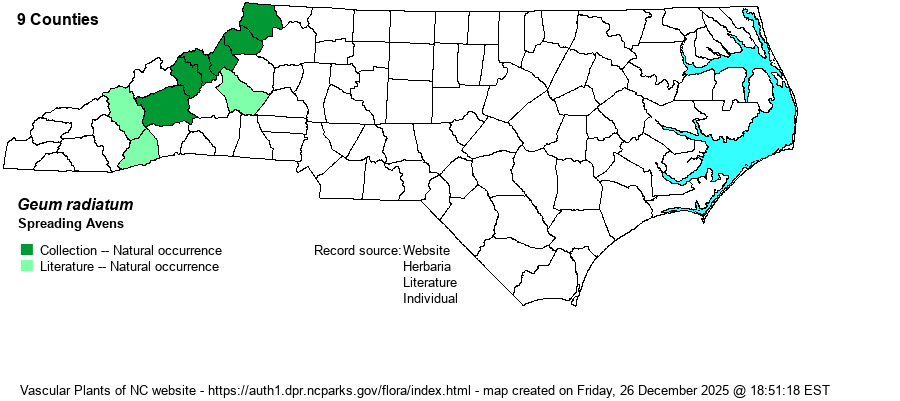| Author | Michaux | |
| Distribution | Scattered over the northern and central Mountains, south only to Haywood and Transylvania counties, strictly at high elevations.
This is a Southern Appalachian endemic, limited only to western NC and adjacent TN.
| |
| Abundance | Locally fairly common on a few peaks, such as Roan Mountain and Grandfather Mountain. Rare to uncommon on other high elevation rocky summit areas. Technically not rare within its limited habitat, but such habitats occupy very little acreage in the Mountains. This is a Federally Endangered species, yet G. geniculatum, with a more limited range, is not. It is also State Endangered. The rank of S2 could be moved to S2S3, though S2 is "conservatively accurate". | |
| Habitat | Unlike G. geniculatum, which is more forest-based and often in or near seeps, this species grows in full sun of rocky summits, crevices, ledges, bluffs, and other exposed rock surfaces at high elevations. Many populations are very dangerous to reach. |
| Phenology | Blooms from June to August, and fruits from July to September. | |
| Identification | This is a completely unique Geum in the state, though it is very similar to a Far Northern species -- G. peckii. This is a rather short species, growing only to about 1 foot tall, with basal leaves being undivided, on long and hispid petioles of a few inches. The leaf blade is rounded to orbicular, about 4 inches wide and long, cordate at the base, with serrated to scalloped margins. The leaves are somewhat shiny above, almost like Galax leaves. The several flowering stems each have a few short branches near the tip, with a rather large flower at the end of each branch. Each of the 5 petals is rounded to obovate and bright yellow, with the spread flower close to 1.5 inches across, with the sepals hidden from view. The species also has a tendency to grow in "patches" or stands over the rocks, and thus is very conspicuous where it occurs, even when not flowering. When in full bloom, it is one of the more spectacular of the wildflowers of the rocky crags and summits in the NC mountains. | |
| Taxonomic Comments | None
| |
| Other Common Name(s) | Cliff Avens, Appalachian Avens | |
| State Rank | S2 | |
| Global Rank | G2 | |
| State Status | E | |
| US Status | LE | |
| USACE-agcp | | |
| USACE-emp | | |

